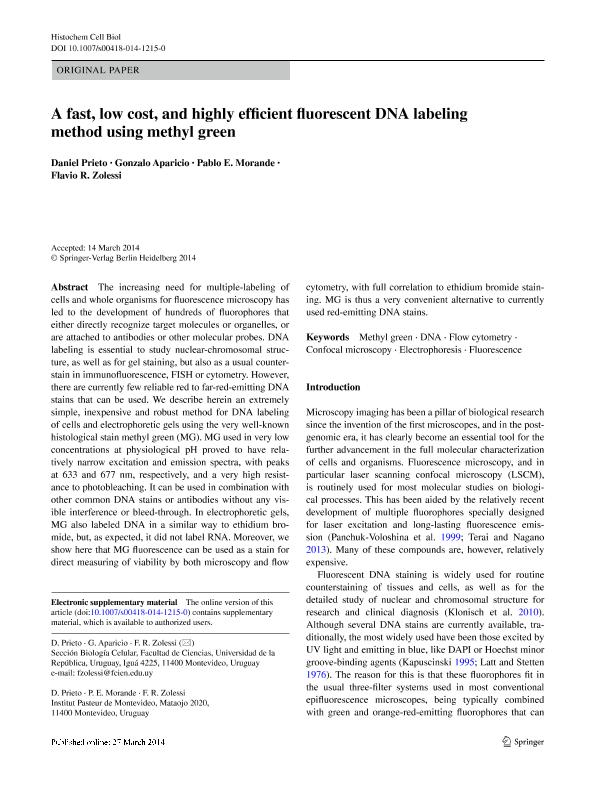Mostrar el registro sencillo del ítem
dc.contributor.author
Prieto, Daniel
dc.contributor.author
Aparicio, Gonzalo
dc.contributor.author
Morande, Pablo Elías

dc.contributor.author
Zolessi, Flavio
dc.date.available
2018-02-06T20:37:27Z
dc.date.issued
2014-09
dc.identifier.citation
Prieto, Daniel; Aparicio, Gonzalo; Morande, Pablo Elías; Zolessi, Flavio; A fast, low cost, and highly efficient fluorescent DNA labeling method using methyl green; Springer; Histochemistry And Cell Biology; 142; 3; 9-2014; 335-345
dc.identifier.issn
0948-6143
dc.identifier.uri
http://hdl.handle.net/11336/35891
dc.description.abstract
The increasing need for multiple-labeling of cells and whole organisms for fluorescence microscopy has led to the development of hundreds of fluorophores that either directly recognize target molecules or organelles, or are attached to antibodies or other molecular probes. DNA labeling is essential to study nuclear-chromosomal structure, as well as for gel staining, but also as a usual counterstain in immunofluorescence, FISH or cytometry. However, there are currently few reliable red to far-red-emitting DNA stains that can be used. We describe herein an extremely simple, inexpensive and robust method for DNA labeling of cells and electrophoretic gels using the very well-known histological stain methyl green (MG). MG used in very low concentrations at physiological pH proved to have relatively narrow excitation and emission spectra, with peaks at 633 and 677 nm, respectively, and a very high resistance to photobleaching. It can be used in combination with other common DNA stains or antibodies without any visible interference or bleed-through. In electrophoretic gels, MG also labeled DNA in a similar way to ethidium bromide, but, as expected, it did not label RNA. Moreover, we show here that MG fluorescence can be used as a stain for direct measuring of viability by both microscopy and flow cytometry, with full correlation to ethidium bromide staining. MG is thus a very convenient alternative to currently used red-emitting DNA stains.
dc.format
application/pdf
dc.language.iso
eng
dc.publisher
Springer

dc.rights
info:eu-repo/semantics/openAccess
dc.rights.uri
https://creativecommons.org/licenses/by-nc-sa/2.5/ar/
dc.subject
Methyl Green
dc.subject
Dna
dc.subject
Flow Cytometry
dc.subject
Confocal Microscopy
dc.subject
Electrophoresis
dc.subject
Fluorescence
dc.subject.classification
Otras Ciencias Biológicas

dc.subject.classification
Ciencias Biológicas

dc.subject.classification
CIENCIAS NATURALES Y EXACTAS

dc.title
A fast, low cost, and highly efficient fluorescent DNA labeling method using methyl green
dc.type
info:eu-repo/semantics/article
dc.type
info:ar-repo/semantics/artículo
dc.type
info:eu-repo/semantics/publishedVersion
dc.date.updated
2018-02-06T20:09:14Z
dc.journal.volume
142
dc.journal.number
3
dc.journal.pagination
335-345
dc.journal.pais
Alemania

dc.journal.ciudad
Berlin
dc.description.fil
Fil: Prieto, Daniel. Universidad de la República; Uruguay. Instituto Pasteur de Montevideo; Uruguay
dc.description.fil
Fil: Aparicio, Gonzalo. Universidad de la República; Uruguay
dc.description.fil
Fil: Morande, Pablo Elías. Consejo Nacional de Investigaciones Científicas y Técnicas; Argentina. Instituto Pasteur de Montevideo; Uruguay
dc.description.fil
Fil: Zolessi, Flavio. Universidad de la República; Uruguay. Instituto Pasteur de Montevideo; Uruguay
dc.journal.title
Histochemistry And Cell Biology

dc.relation.alternativeid
info:eu-repo/semantics/altIdentifier/doi/http://dx.doi.org/10.1007/s00418-014-1215-0
dc.relation.alternativeid
info:eu-repo/semantics/altIdentifier/url/https://link.springer.com/article/10.1007%2Fs00418-014-1215-0
Archivos asociados
